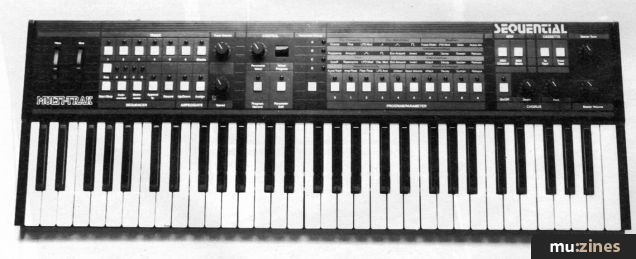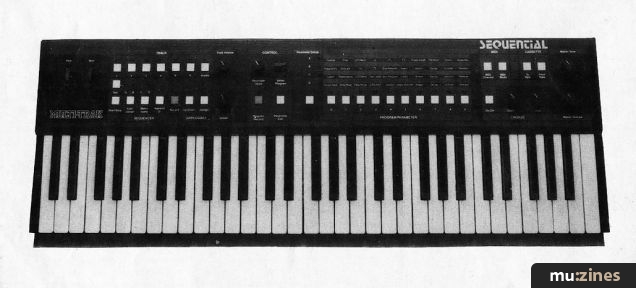Magazine Archive
Home -> Magazines -> Issues -> Articles in this issue -> View
Sequential Multi-Trak | |
Article from One Two Testing, June 1985 | |
poly, touch sensitive timbrillity

MULTI-TIMBRAL was a phrase Sequential originally coined to describe their Six-Trak synth — a keyboard that could play six notes polyphonically on one sound, or one note 'multi-timbrally' containing six sounds. The on-board sequencer could similarly remember a sextet of different lines, sounds and levels which you could alter at your leisure when all the note punching had been done.
The world hasn't rushed to snatch 'multi-timbral' from the Sequential phrase book, so their follow-up device, the Multi-Trak, remains the only budget analogue synth to showcase this talent.
The Six-Trak has been compressed and expanded to reach this point. It's in a smaller, flatter case (similar to the pre-set Max that Sequential used to fill the interval of late '84), with additional memory and wider powers for its timbralic activity. And it presents a five (not four) octave touch sensitive C to C keyboard, unusually heavily sprung.
Programming is by the ubiquitous parameter control, and is neatly done. The horizontal row of ten white program buttons will (dependent on 'mode') select one of the 100 patches, or choose a parameter out of four sub groups, A to D. Each sub group has its own LED, followed by its ten parameters, written on the front panel, above the buttons that call them up. Pick group and parameter, and tweak the value knob to do the business.
The memory is much finer than the Six-Trak. Most of the parameters have 32 steps, the more fussy ones have 64 and the essentially finicky filter cut-off gets 128. Sequential have always stuck to their own ideas on how a synthesiser should sound, such as the mixable ramp, triangle and square waveforms, and the extra ADSR envelope generator, reserved for loonying about with the oscillator pitch.
Sequential sounds can often be spotted by the way they move a bit more than other analogue keyboards, whooping up or down to their notes and then shifting pitch as they decay. If you like this, you will find it here, easily, and without tying up the rest of your envelope generators.
However, we be surprised to find an analogue synth at this price with only one oscillator bank. (Yes, I know the built-in chorus can fatten an already thick sound, and that the current trend is back towards brighter, thinner noises, but it does cut out cross modulation, syncing and interval tuning. Side by side, in a dealer's doorway, the Multi-Trak could seem less versatile than the opposition.)
There are ADSRs for the oscillator, filter and amplifier envelopes; polyphonic glide; pulse width mod; triangle and square LFO waveforms, plus the velocity sensitivity which can be directed to the amplifier (volume), filter (brightness) or LFO amount. A thoroughgoing, if conservative set of facilities.
With its 16 steps, the touch sensitivity is twice as wide as some keyboards (seven for the DXs, for example). Consequently you can go from top volume to almost nothing. I found the heavily sprung keyboard inhibited me, but I did go for the fact that each note was individually touch sensitive. With practice (a lot) you could give every note of a six-part chord its own level, brightness and LFO amount instead of all the notes you're holding being 'overruled' in expression by the loudest one you played. Having the LFO amount linked to velocity sensitivity is a definitively gear idea as you can up the vibrato on one note by hitting it a touch harder than the rest.
There are now four separate sequences (instead of two), a total of 1600 notes memory space, and it remembers your velocity expression. Once kicked off the sequences will loop indefinitely, you can swap between them, or pre-select an alternating pair with the 'append' button. The Multi-Trak will auto correct to 8th or 16th notes (you choose), or do away with correction all together (chewing up more memory). Ideally all sequencers would be like this as the Multi-Trak's is not only easy to record but simple to correct later.
Lines can be recorded to a metronome, monophonically or polyphonically, depending how many of the six 'track' buttons you press. On overdubs, voice selections are automatically remembered, and because the backing track repeats indefinitely, you keep playing the fresh dub until you're satisfied, then stop. Each new loop writes over the last. The Multi-Trak starts recording when you play the first note, stops when you take your finger off the last. Every track has an individual audio output, and the inclusion of ten drum sounds in the factory-loaded programs (all re-writable) let you put together synthesised rhythm backings (a Linn it is not). Very fast (though the autocorrect can get pedantic), inventive, always open ended. You can edit the voice selection or volume (16 steps) of each track once recording is finished and knock out one track or any number, or a single note. But it is a live sequencer, for preparing short, repeating 'blowable' verses and patterns, not a machine to write your next concept album on.
The Multi-Trak can be split anywhere, with any balance of notes on either side. The voice stacking facility on the original Six-Trak has been incorporated in this section so you can now have, say, two different combinations of voices either side of a split; four notes of one sound against a mono stack of two; two notes of two sounds against one of two and so on. The Multi-Trak will store ten of these performance patches. It's a considerable extension of the Six-Trak's abilities and important for someone who wants a synth that can play solid monophonic lines, as well as chord parts — not always the case with budget polys.
To finish there are pitch and mod wheels on the panel above the keys, tape dump for memories, MIDI in and out (plus a comprehensive manual to go with it), an arpeggiator and, less joyously, an external power supply connected via a weird five-pin DIN socket. It may keep down the weight and size of the keyboard itself but (a) you still have to carry it around (b) it stands a greater risk of being damaged as a separate unit and (c) lose it and you're done for.
Final important point for sequencer-ish people — you can drive the Multi-Trak from an external drum machine (turning the tempo control fully anticlockwise switches to an external clock which should be 24 pulses per quarter note), or let the synth lay down its own sync track on tape to layer up sequences.
I made friends with the synth, but fell out with the (non-discount) price.
SEQUENTIAL Multi-Trak poly: £1700
CONTACT: Sequential, (Contact Details)
Also featuring gear in this article
SCI Multi-Trak - Synthcheck
(IM Apr 85)
Trak-Fakts - Sequential Multi-Trak
(ES May 85)
Browse category: Synthesizer > Sequential Circuits
Publisher: One Two Testing - IPC Magazines Ltd, Northern & Shell Ltd.
The current copyright owner/s of this content may differ from the originally published copyright notice.
More details on copyright ownership...
Review by Paul Colbert
Help Support The Things You Love
mu:zines is the result of thousands of hours of effort, and will require many thousands more going forward to reach our goals of getting all this content online.
If you value this resource, you can support this project - it really helps!
Donations for April 2024
Issues donated this month: 0
New issues that have been donated or scanned for us this month.
Funds donated this month: £7.00
All donations and support are gratefully appreciated - thank you.
Magazines Needed - Can You Help?
Do you have any of these magazine issues?
If so, and you can donate, lend or scan them to help complete our archive, please get in touch via the Contribute page - thanks!





